
Introduction
Durga Puja is one of the most important and popular festivals of Hinduism, especially in the eastern and northeastern parts of India. It is a celebration of the victory of the goddess Durga over the demon Mahishasura, who symbolizes evil and ignorance. Durga Puja also honors the motherly aspect of the goddess, who is revered as the source of power, wisdom, and compassion. Let’s delve into the various aspects of this vibrant festival:
Durga Puja is celebrated for ten days in the month of Ashvina (September-October), according to the Hindu lunar calendar. The last five days, from Shashthi to Dashami, are the most significant and festive. During this time, devotees worship Durga and her four children – Ganesha, Kartikeya, Lakshmi, and Saraswati – in elaborately decorated pandals (temporary structures) or temples. They also enjoy cultural programs, visit friends and relatives, exchange gifts, and feast on delicious food.
Durga Puja has a rich history and tradition that dates back to ancient times. According to some legends, Durga Puja was first performed by Lord Rama before his battle with Ravana, as a way of invoking the goddess’s blessings. According to others, Durga Puja was initiated by King Suratha and a merchant named Samadhi, who were guided by a sage named Medhas to worship Durga as a means of overcoming their worldly troubles. Over time, Durga Puja evolved into a social and cultural festival that reflects the diversity and creativity of the Bengali community.
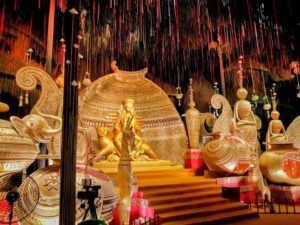
Importance of Durga Puja:
- Goddess Durga’s Triumph over Evil: Durga Puja commemorates the victory of Goddess Durga over the demon king Mahishasura. It symbolizes the triumph of good over evil, righteousness over unrighteousness.
- Unity and Diversity: This festival brings people of different communities and backgrounds together. It transcends religious boundaries and fosters a sense of unity among diverse groups.
- Cultural Significance: Durga Puja is a celebration of Bengali culture, art, music, and literature. It showcases the rich heritage and creativity of the Bengali community.
- Spiritual Renewal: Devotees believe that participating in Durga Puja purifies the soul and renews their spiritual energy.
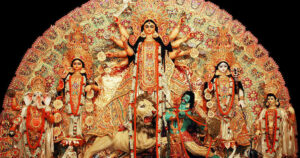
Durga Maa
Why it is Celebrated:
- Navaratri Festival: Durga Puja marks the culmination of the nine-day Navaratri festival, dedicated to the worship of the Goddess Durga and her various forms.
- Honoring the Divine Feminine: It is a tribute to the feminine aspect of the divine, representing strength, power, and protection.
- Celebration of Motherhood: Durga Puja also celebrates motherhood and the nurturing qualities of the Goddess.
Tradition and Rituals:
- Mahalaya: The festival kicks off with Mahalaya, a day when devotees offer prayers to their ancestors and invoke Goddess Durga.
- Pandals and Idols: Elaborate pandals (temporary structures) are erected, and artistic idols of Goddess Durga and her entourage are installed. These idols are intricately crafted by skilled artisans.
- Puja Ceremonies: Elaborate rituals including ‘Saptami’, ‘Ashtami’, ‘Navami’, and ‘Vijaya Dashami’ are performed, which involve offering flowers, fruits, and other offerings to the Goddess.
- Sindoor Khela: On Vijaya Dashami, married women participate in Sindoor Khela, a tradition where they apply vermilion to each other and the idols, symbolizing marital bliss and the triumph of good over evil.
- Visarjan (Immersion): On the last day, the idols are taken in grand processions to nearby rivers or water bodies for immersion, accompanied by music and dance.
- Dhunuchi Naach: This is a traditional dance form performed with a clay lamp, usually during the evening arati (worship with fire) ceremonies.
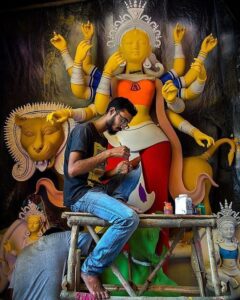
Artist
Festival Atmosphere:
- Cultural Extravaganza: Durga Puja is not just a religious festival; it’s a cultural extravaganza. It involves various cultural events like dance performances, music concerts, and art exhibitions.
- Feasting and Festivities: Mouthwatering delicacies are prepared, including traditional Bengali sweets like ‘rosogolla’ and ‘sandesh’. Families and friends come together to celebrate and share meals.
- Pandal Hopping: People indulge in “pandal hopping,” where they visit different puja pandals to admire their artistic creativity and craftsmanship.
- Carnival-like Atmosphere: The streets are filled with vibrant processions, joyous singing, and enthusiastic dancing.
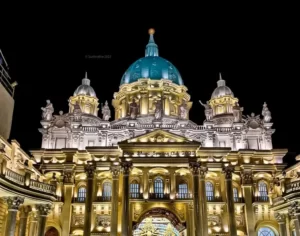
Durga Puja Pandal 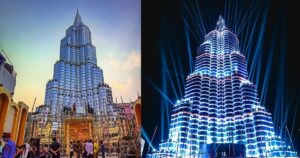
Burj Khalifa Pandal
Facts about Durga Puja:
Durga Puja is also celebrated in other parts of India and abroad, with some regional variations. For instance, in North India, Durga Puja coincides with Navratri, a nine-day festival dedicated to different forms of the goddess. In South India, Durga Puja is associated with Bommai Kolu or Golu, a display of dolls depicting various gods and goddesses. In Nepal, Durga Puja is known as Dashain and is marked by animal sacrifices and kite flying. In Bangladesh, Durga Puja is called Bhagabati Puja or Sharadiya Puja and is celebrated by both Hindus and Muslims as a symbol of harmony.
- Historical Roots: The first recorded Durga Puja dates back to the late 16th century in Bengal.
- Global Celebration: Durga Puja is celebrated worldwide, especially in countries with a significant Bengali diaspora, including the USA, UK, and Australia.
- Economic Impact: The festival has a substantial economic impact, as it supports various industries like idol-making, pandal construction, and the hospitality sector.
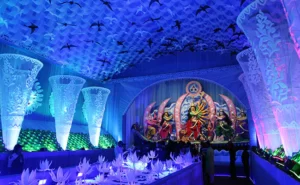
Interior of Pandal 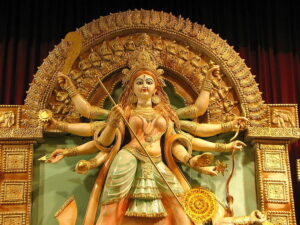
Maa Durga
Nine Days Of Navratri:
First Day Puja
The first day of Navratri Puja is devoted to Shailputri. Goddess Shailputri is the daughter of the Himalayas. She is a form of Mata Shakti (Goddess of Power) and spouse of Lord Shiva.
Second Day Puja
On the second day of Navratri, Goddess Brahmacharini is worshipped in homes and temples. The word ‘Brahmcharini’ is derivative of the word Brahma, which stands for Tapa (Penance). This form of mata Shakti is close to Uma or Parvati.
Third Day Puja
Goddess Chandraghanta is worshipped on the third day of Navratri. She is considered to be a Goddess of beauty and bravery.
Fourth Day Puja
The form of Mata Shakti which is worshipped fourth day of Navratri is Kushmanda. As per Hindu mythology, it is considered that the Goddess Kushmanda originated this entire Universe through her laugh.
Fifth Day Puja
Devotees worship Skand Mata on the fifth day of Navratri. Skanda is the chief warrior of God’s army and Goddess is the mother of Skanda that is why the Goddess is called Skand Mata.
Sixth Day Puja
The sixth day of Navratri is intended for Devi Katyayani. In her typical image, the goddess Katyayani is seated on a lion and has three eyes and four legs.
Seventh Day Puja
On the seventh day of the Navratri festival, devotees worship and adore the Goddess Kalratri. As the name indicates Devi Kalratri is as black as a dark night and she is notorious for eliminating fear from her devotee’s heart.
Eighth Day Puja
Maha Gauri is the form of Mother Durga which is worshipped on the eighth day of Navratri. The Goddess Maha Gauri signifies calmness and endorses wisdom. As the name suggests, she is considered enormously beautiful. Her color is like snow and adorned with white-colored jewelry.
Ninth Day Puja
The ninth form of the Goddess Durga, Siddhidatri is worshiped on the ninth day of Navratri. She is the Goddess of all eight Siddhis and is worshipped by all Yogis, Sadhakas, Siddhas, and RIshis-Munis.
Durga Puja in 2023:
In 2023, Durga Puja will be celebrated from Friday, October 20, 2023, to Tuesday, October 24, 2023.
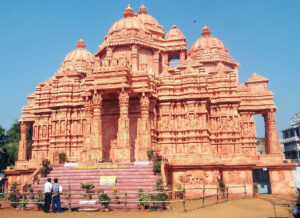
Conclusion:
Durga Puja stands as a testament to the power of faith, unity, and cultural diversity. It is not only a religious celebration but a grand carnival of art, music, and community spirit. The festival’s essence lies in its ability to unite people, transcend boundaries, and celebrate the victory of good over evil. As the enchanting idols of Goddess Durga are immersed in the flowing waters, the spirit of hope, renewal, and triumph lingers on, reminding us of the eternal power of righteousness.
Leave a Reply